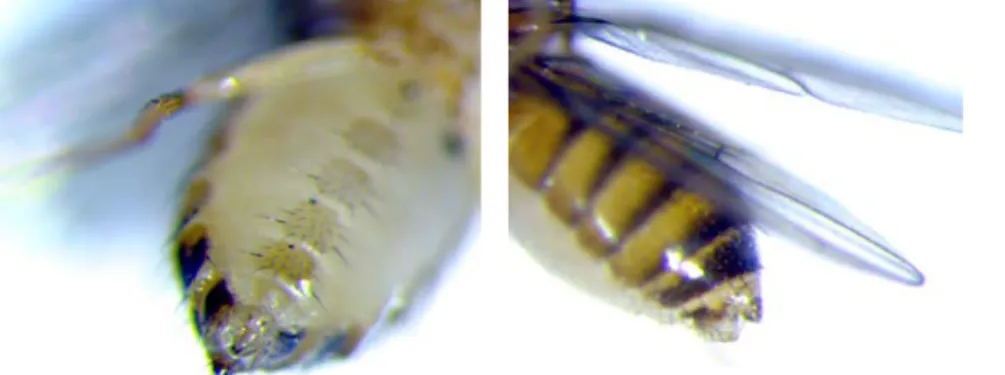Dros. Inf. Serv. 98 (2015)
Mutation Notes
167
Despite the many thousands of ch cu chromosomes that we have observed —either in heterokaryotypic F1 larvae or directly in ch cu strain larvae— over the long period elapsed, we had never detected any discordant arrangement in ch cu chromosomes.
During one of our in situ hybridization experiments, we realized that the pair of E chromosomes from one ch cu larva was heterokaryotipic for an inversion (Figure 1). We could readily discard an accidental contamination of the ch cu strain from other D. subobscura strains of the Barcelona area maintained in our laboratory, since the rest of chromosomes were homokaryotypic for the ch cu strain arrangements Ast, Jst, Ust , and O3+4, which are at rather low frequency in the Barcelona area. Moreover, upon closer inspection of the inversion span, we could confirm that this was a new inversion, since its cytological breakpoints correspond to sections 63C/64A and 70C/70D of the Kunze-Mühl and Müller (1958) map, which are not shared by any other spontaneous known inversion. We named this inversion E24.
The spontaneous origin of a new inversion in a laboratory strain that is normally used to determine the karyotype of wild-caught individuals might raise concerns relative to the identification of inversions newly originated in natural populations. Indeed, if the rate of origin of inversions in laboratory strains were high — which does not seem to be the case for the ch cu strain—, some of the inversions newly described as having originated in natural populations might have actually originated in the laboratory strain used to karyotype wild-caught individuals.
References: Balanyà J., L. Serra, G.W. Gilchrist, R.B. Huey, M. Pascual, F. Mestres, and E. Solé 2003, Evolution 57(8): 1837–1845; Gosteli, M., and E. Hauschteck-Jungen 1989, Genetica 79: 115-120; Krimbas, C.B., 1992, In: Drosophila Inversion Polymorphism (Krimbas, C.B., and J.R. Powell, eds.), pp. 127-220. CRC Press, Boca Ratón; Kunze-Mühl, E., and E. Müller 1958, Chromosoma 9: 559–570; Orengo, D.J., 1992, Correlación entre el polimorfismo cromosómico y el tamaño del cuerpo en Drosophila subobscura. Ph.D. thesis. Universitat de Barcelona, Barcelona. 173 pp; Orengo, D.J., and A. Prevosti 1992, Dros. Inf. Serv. 71: 159-160; Orengo, D.J., E. Puerma, M. Papaceit, C. Segarra, and M. Aguadé 2015, Heredity 114: 610-618; Prevosti, A., G. Ribó, M.P. García, E. Sagarra, M. Aguadé, L. Serra, and M. Monclús 1982, Actas V Congr. Latinoam. Genética p: 189-197; Segarra, C., and M. Aguadé 1992, Genetics 130: 513-521; Zouros, E., and C.B. Krimbas 1973, Genetics 73: 659-674.
Abnormal ovipositor in a Drosophila melanogaster female.
Romero, R.and F. Mestres*. Dept. Genètica, Universitat de Barcelona, Barcelona (Spain).
*
Corresponding author: [email protected].
While collecting virgin females from a wild stock, we found a female with an abnormal ovipositor (Figures 1, abnormal; Figure 2, normal). The stock was obtained from wild D. melanogaster flies collected at the Font Groga site, near Barcelona, in autumn 2012 (Canals et al., 2013). Unfortunately, it was not possible to cross this female, and we did not have any information on her parents because she appeared in a mass culture.
Figure 1. Abnormal ovipositor (ventral and lateral views).
Mutation Notes
Dros. Inf. Serv. 98 (2015)
168
References: Canals, J., J. Balanyá, and F. Mestres 2013, Dros. Inf. Serv. 96: 185-186.
Figure 2. Normal ovipositor (ventral and lateral views).

